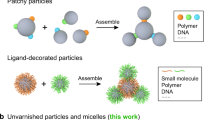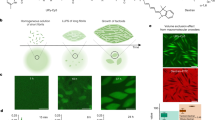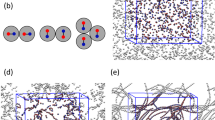Abstract
The difficulty of mixing chemically incompatible substances—in particular macromolecules and colloidal particles—is a canonical problem limiting advances in fields ranging from health care to materials engineering1,2,3,4. Although the self-assembly of chemically different moieties has been demonstrated in coordination complexes, supramolecular structures, and colloidal lattices among other systems5,6,7,8,9,10,11,12,13,14,15,16,17,18, the mechanisms of mixing largely rely on specific interfacing of chemically, physically or geometrically complementary objects. Here, by taking advantage of the steric repulsion between brush-like polymers tethered to surface-active species, we obtained long-range arrays of perfectly mixed macromolecules with a variety of polymer architectures and a wide range of chemistries without the need of encoding specific complementarity. The net repulsion arises from the significant increase in the conformational entropy of the brush-like polymers with increasing distance between adjacent macromolecules at fluid interfaces. This entropic-templating assembly strategy enables long-range patterning of thin films on sub-100 nm length scales.
This is a preview of subscription content, access via your institution
Access options
Subscribe to this journal
Receive 12 print issues and online access
$259.00 per year
only $21.58 per issue
Buy this article
- Purchase on Springer Link
- Instant access to full article PDF
Prices may be subject to local taxes which are calculated during checkout




Similar content being viewed by others
References
Freed, K. F. & Dudowicz, J. Influence of monomer molecular structure on the miscibility of polymer blends. Adv. Polymer Sci. 183, 63–126 (2005).
Higgins, J. S., Lipson, J. E. G. & White, R. P. A simple approach to polymer mixture miscibility. Phil. Trans. R. Soc. A 368, 1009–1025 (2010).
Wolf, B. A. Making Flory–Huggins Practical: Thermodynamics of polymer-containing mixtures. Adv. Polymer Sci. 238, 1–66 (2011).
Ganesan, V., Ellison, C. J. & Pryamitsyn, V. Mean-field models of structure and dispersion of polymer-nanoparticle mixtures. Soft Matter 6, 4010–4025 (2010).
Park, S. Y. et al. DNA-programmable nanoparticle crystallization. Nature 451, 553–556 (2008).
Nykypanchuk, D., Maye, M. M., van der Lelie, D. & Gang, O. DNA-guided crystallization of colloidal nanoparticles. Nature 451, 549–552 (2008).
Valignat, M., Theodoly, O., Crocker, J., Russel, W. & Chaikin, P. Reversible self-assembly and directed assembly of DNA-linked micrometer-sized colloids. Proc. Natl Acad. Sci. USA 102, 4225–4229 (2005).
Chen, Q., Bae, S. C. & Granick, S. Directed self-assembly of a colloidal kagome lattice. Nature 469, 381–385 (2011).
Liu, J., Zhang, Y. & Zhang, J. M. Stereocomplexation and monolayer morphologies of a stereoregular poly(methyl methacrylate) mixture formed at the air/water surface. J. Phys. Chem. C 111, 6488–6494 (2007).
Shevchenko, E. V., Talapin, D. V., Kotov, N. A., O’Brien, S. & Murray, C. B. Structural diversity in binary nanoparticle superlattices. Nature 439, 55–59 (2006).
Leunissen, M. E. et al. Ionic colloidal crystals of oppositely charged particles. Nature 437, 235–240 (2005).
Bartlett, P. & Campbell, A. I. Three-dimensional binary superlattices of oppositely charged colloids. Phys. Rev. Lett. 95, 128302–128302 (2005).
Sacana, S., Irvine, W. T. M., Chaikin, P. M. & Pine, D. J. Lock and key colloids. Nature 464, 575–578 (2010).
Glotzer, S. C. & Solomon, M. J. Anisotropy of building blocks and their assembly into complex structures. Nature Mater. 6, 557–562 (2007).
Mann, S. Self-assembly and transformation of hybrid nano-objects and nanostructures under equilibrium and non-equilibrium conditions. Nature Mater. 8, 781–792 (2009).
Liu, K. et al. Step-growth polymerization of inorganic nanoparticles. Science 329, 197–200 (2010).
Aiba, N., Sasaki, Y. & Kumaki, J. Strong compression rate dependence of phase separation and stereocomplexation between isotactic and syndiotactic poly(methyl methacrylate)s in a Langmuir monolayer observed by atomic force microscopy. Langmuir 26, 12703–12708 (2010).
Mayer, A. C. et al. Bimolecular crystals of fullerenes in conjugated polymers and the implications of molecular mixing for solar cells. Adv. Funct. Mater. 19, 1173–1179 (2009).
Choi, I., Gunawidjaja, R., Suntivich, R., Tsitsilianis, C. & Tsukruk, V. V. Surface behavior of PSn(P2VP-b-PtBA)n heteroarm stars. Macromolecules 43, 6818–6828 (2010).
Zhang, D., Carignano, M. A. & Szleifer, I. Cluster structure and corralling effect driven by interaction mismatch in two dimensional mixtures. Phys. Rev. Lett. 96, 028701 (2006).
Singh, C. et al. Entropy-mediated patterning of surfactant-coated nanoparticles and surfaces. Phys. Rev. Lett. 99, 226106 (2007).
Delaunay, B. N. Sur la sphére, vide. Izv. Akad. Nauk SSSR, Otd. Matemat. Estestv. Nauk 7, 793–800 (1934).
Matyjaszewski, K. & Xia, J. Atom transfer radical polymerization. Chem. Rev. 101, 2921–2990 (2001).
Acknowledgements
The authors thank E. T. Samulski for insightful discussions and reviewing the paper. S.S.S., A.V.D., V.V.T. and M.R. acknowledge financial support from the National Science Foundation DMR-0906985, DMR-1004576, DMR-1122483, DMR-1002810 and DMR-0907515.
Author information
Authors and Affiliations
Contributions
S.S.S. wrote the manuscript and supervised the project, J.Z. and J.A. performed the experiments, D.N. and C.T. synthesized materials, J-M.Y.C. performed Monte Carlo modelling of 2D patterns, A.V.D. and M.R. developed theoretical analysis of interfacial mixing, and K.M. and V.V.T. discussed results and contributed to revisions.
Corresponding author
Ethics declarations
Competing interests
The authors declare no competing financial interests.
Supplementary information
Supplementary Information
Supplementary Information (PDF 914 kb)
Rights and permissions
About this article
Cite this article
Sheiko, S., Zhou, J., Arnold, J. et al. Perfect mixing of immiscible macromolecules at fluid interfaces. Nature Mater 12, 735–740 (2013). https://doi.org/10.1038/nmat3651
Received:
Accepted:
Published:
Issue Date:
DOI: https://doi.org/10.1038/nmat3651
This article is cited by
-
Searching for the synthetic methods towards siloxane molecular brushes
Russian Chemical Bulletin (2024)
-
Role of Conformational Entropy in Complex Macromolecular Systems
Chemical Research in Chinese Universities (2023)
-
Mixing of immiscible polymers using nanoporous coordination templates
Nature Communications (2015)
-
Entropic templating
Nature Materials (2013)



